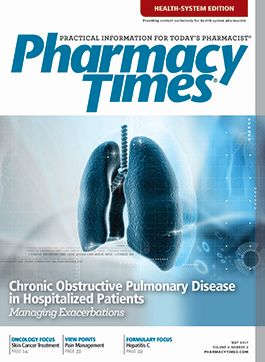Publication
Article
Pharmacy Practice in Focus: Health Systems
Penicillin Allergies and Cross-Reactivity With Other Beta-Lactams
Patient-reported allergy to penicillin antibiotics is a common scenario during health care encounters, with an estimated population prevalence of roughly 8% to 12%.
Patient-reported allergy to penicillin antibiotics is a common scenario during health care encounters, with an estimated population prevalence of roughly 8% to 12%.1 Primary reactions to penicillin antibiotics include rash, itching, nausea and vomiting, shortness of breath, and anaphylaxis.
Despite the high population prevalence, 80% to 90% of those reporting a penicillin allergy will have a negative response to penicillin skin testing.2 Thus, with a true rate of penicillin allergy likely much lower than that reported by patients, health care professionals are often placed in a predicament regarding the selection of empiric antimicrobial therapy to treat a wide array of infectious conditions.
Often, when patients are labeled as having a penicillin allergy, providers are forced to approach the scenario conservatively and simply avoid using beta-lactams.1 This strategy will frequently lead to suboptimal regimens, including therapies that may be inferior to beta-lactam—based regimens or those that may have unnecessarily broad or inappropriately narrow spectrums of activity.
It is important to ascertain a patient’s reported reaction and reaction timing with regard to administration to help indicate whether the allergy represents an immunoglobin (IgE)-mediated reaction, a delayed-onset reaction, an adverse effect, or simply an intolerance.3 If a patient’s penicillin allergy is determined by reaction severity or allergy testing to represent a true allergy, then the clinician is faced with the challenge of determining and interpreting the rate of allergic cross-reactivity from the penicillin class to the other beta-lactam classes (ie, cephalosporins, carbapenems, and mono-bactams). Understanding the possible cross-reactivity will help a provider assess the risk to the patient and ultimately decide whether a nonpenicillin beta-lactam should be used.
For cephalosporins, the rate of cross-reactivity with penicillins is lower than previously believed. A common myth is that about 10% of patients with a penicillin allergy history will experience an allergic reaction if administered a cephalosporin. This rate derived from early cross-reactivity studies seems to have been caused, at least partially, by contamination of early preparations of cephalosporins with trace amounts of penicillin G.4 However, more recent observational studies have found cross-reactivity rates of between 0.17% and 0.7%.5-9 In 1 prospective study, the rate of cross-reactivity among subjects with a positive penicillin skin test was 6%.7
It appears that cross-reactivity between penicillins and cephalosporins is more likely associated with structurally similar side chains rather than the beta-lactam ring itself.10 For instance, amoxicillin has a side chain identical to that of first-generation cephalosporins cefadroxil and cefprozil, whereas ampicillin has a side chain identical to that of first-generation cephalosporins cephalexin and cephradine, as well as to that of cefaclor, a second-generation cephalosporin. This is in direct contrast to later-generation cephalosporins, where there is little to no side chain similarity to those side chains seen in the penicillin class.10 Risk of cross-reactivity may still remain a concern even with dissimilar side chains; therefore, it is prudent to avoid other beta-lactams in patients with a history of IgE-mediated or severe non—IgE-mediated reactions to penicillins, especially in the absence of skin testing or documentation of successful receipt of other beta-lactams.
Aztreonam is less immunogenic and is associated with fewer allergic reactions compared with other beta-lactams. It can be used safely in patients allergic to other beta-lactams due to dissimilarities in the chemical structure. In vitro data, skin tests, and patient challenge studies found no risk of cross-reactivity to other beta-lactam allergies.11-17 The exception to this rule appears to be ceftazidime, which has an identical side chain to that of aztreonam; therefore, the risk of cross-reactivity between these 2 agents exists and should be avoided.13
With regard to the carbapenems, the overall rate of hypersensitivity reactions encountered in the general population is thought to be less than 3%.18 Carbapenems and penicillins do not share common side chains; therefore, the primary structural similarity that may confer allergic cross-sensitivity to those with a true penicillin allergy is the molecule’s bicyclic core.2 The first study that attempted to evaluate the possible cross-reactivity rate from penicillin allergy to carbapenems evaluated the possible cross-reactivity to imipenem.19 This prospective study enrolled 59 total participants and used skin testing only without subsequent systemic administration challenge. The researchers found a cross-reactivity rate to imipenem of 25.6% for those with reported penicillin allergy and 47.4% for those with confirmed penicillin allergy.19 This potential rate of cross-reactivity was alarming; however, this study had a small sample size and used a nonstandard imipenem skin test. These 2 factors led many to evaluate the study’s for clinical application cautiously.
Since this initial study, further studies with varied designs, methodologies, and patient populations have implicated a cross-reactivity rate of somewhere between 0.9% and 11%.2 When further examined, prospective studies that used appropriate penicillin and carbapenem skin testing, and in which patients negative for reaction to carbapenem skin testing received a systemic dose of carbapenem, are likely best positioned to help guide the use of carbapenems in this scenario. In these studies, the rate of true cross-reactivity from a positive penicillin skin test to a positive carbapenem skin test was roughly 1% and patients with negative carbapenem skin testing tolerated system- ic doses of carbapenems without reaction.20-22 From this data, the rate of true cross-reactivity to carbapenems in patients who are allergic to penicillin appears to be very low.
The following approach can be considered to address beta- lactam antibiotic cross-reactivity concern in the treatment of acute infectious processes. For patients with history of suspected or proven IgE-mediated reaction to penicillin, clinicians should consider an alternative antibiotic or perform desensitization if no reasonable alternatives are available. For patients with a history of non—IgE-mediated reaction, the feasibility of beta-lactam allergy challenge should be determined based on reaction severity and the agent’s side chain similarity. For patients with a history of severe non–IgE-mediated reaction, such as Stevens-Johnson syndrome or hemolytic anemia, use of an alternative antibiotic class should be advised. For patients with a history of nonsevere, non–IgE-mediated reactions to penicillins, cephalosporins and carabapenems need not be avoided; however, consideration should be given to using agents with dissimilar side chains as appropriate.10
In conclusion, true rates of cross-reactivity from penicillins to cephalosporins and carabapenems appear to be low. Thus, in clinical settings that lack access to allergy skin testing, thorough consideration of the risk versus benefit of cephalosporin or carbapenem exposure should be considered prior to administration in patients who report a penicillin allergy. Except in the circumstance of IgE-mediated or severe non—IgE-mediated allergy, other beta-lactams should not be avoided and the risk of cross-reactivity may be further reduced by using agents with dissimilar side chains. Aztreonam lacks cross-reactivity to other beta-lactam antibiotics and may be safely given to patient claiming allergy to beta-lactam antibiotics, with the exception of patients allergic to ceftazidime.13
RYAN STEVENS graduated with his PharmD from the University of Montana in 2010. He subsequently completed a PGY1 pharmacy practice residency at Alaska Native Medical Center in Anchorage, AK. Following residency, Dr Stevens was employed by Providence Alaska Medical Center as a clinical pharmacist in Adult Critical Care, and he is currently employed there as the Infectious Diseases Clinical Pharmacy Specialist. He is active within his specialty through participation in antimicrobial stewardship activities within the Providence Health and Services system, the Alaska Antimicrobial Stewardship Collaborative, and the Society of Infectious Diseases Pharmacists.
KHALID ELJAALY, PHARMD, CAPPS, BCPS, MS, is a postdoctoral pharmacy fellow in infectious diseases/antibiotic stewardship in the University of Arizona, Tucson, and a faculty member in the clinical pharmacy department, King Abdulaziz University, Jeddah, Saudi Arabia. He completed his PGY2 pharmacy residency at Beth Israel Deaconess Medical Center in Boston, a hospital affiliated with Harvard Medical School. He is a member of the social media committees of both the Society of Infectious Diseases Pharmacists and the Infectious Diseases Practice and Research Network of the American College of Clinical Pharmacy. His Twitter account is called “Antibiotic Tweets” and his handle is @khalideljaaly.
References
- Albin S, Agarwal S. Prevalence and characteristics of reported penicillin allergy in an urban outpatient adult population. Allergy Asthmas Proc. 2014;35(6):489-494. doi: 10.2500/aap.2014.35.3791.
- Frumin J, Gallagher JC. Allergic cross-sensitivity between penicillin, carbapenem, and monobactam antibiotics: what are the chances? Ann Pharmacother. 2009;43(2):304-315. doi: 10.1345/aph.1L486.
- DePestel DD, Benninger MS, Danziger L, et al. Cephalosporin use in treatment of patients with penicillin allergies. J Am Pharm Assoc (2003). 2008;48(4):530-540. doi: 10.1331/JAPhA.2008.07006.
- Herbert ME, Brewster GS, Lanctot-Herbert M. Medical myth: ten percent of patients who are allergic to penicillin will have serious reactions if exposed to cephalosporins. West J Med. 2000;172(5):341.
- Goodman EJ, Morgan MJ, Johnson PA, Nichols BA, Denk N, Gold BB. Cephalosporins can be given to penicillin-allergic patients who do not exhibit an anaphylactic response. J Clin Anesth. 2001;13(8):561-564.
- Daulat SB, Solensky R, Earl HS, Casey W, Gruchalla RS. Safety of cephalosporin administration to patients with histories of penicillin allergy. J Allergy Clin Immunol. 2004;113(6):1220-1222.
- Park MA, Koch CA, Klemawesch P, Joshi A, Li JT. Increased adverse drug reactions to cephalosporins in penicillin allergy patients with positive penicillin skin test. Int Arch Allergy Immunol. 2010;153(3):268-273. doi: 10.1159/000314367.
- Ahmed KA, Fox SJ, Frigas E, Park MA. Clinical outcome in the use of cephalosporins in pediatric patients with a history of penicillin allergy. Int Arch Allergy Immunol. 2012;158(4):405-410. doi: 10.1159/000333553.
- Beltran RJ, Kako H, Chovanec T, Ramesh A, Bissonnette B, Tobias JD. Penicillin allergy and surgical prophylaxis: cephalosporin cross-reactivity risk in a pediatric tertiary care center. J Pediatr Surg. 2015;50(5):856-859. doi: 10.1016/j.jpedsurg.2014.10.048.
- Joint Task Force on Practice Parameters; American Academy of Allergy, Asthma and Immunology; American College of Allergy, Asthma and Immunology; Joint Council of Allergy, Asthma and Immunology. Drug allergy: an updated practice parameter. Ann Allergy Asthma Immunol. 2010;105(4):259-273. doi: 10.1016/j.anai.2010.08.002.
- Adkinson NF Jr. Immunogenicity and cross-allergenicity of aztreonam. Am J Med. 1990;88(3C):S3-S14.
- Saxon A, Hassner A, Swabb EA, Wheeler B, Adkinson NF Jr. Lack of cross-reactivity between aztreonam, a monobactam antibiotic, and penicillin in penicillin-allergic subjects. J Infect Dis. 1984;149(1):16-22.
- Saxon A, Swabb EA, Adkinson NF Jr. Investigation into the immunologic cross-reactivity of aztreonam with other beta-lactam antibiotics. Am J Med. 1985;78(2A):19-26.
- Vega JM, Blanca M, Garcia JJ, et al. Tolerance to aztreonam in patients allergic to beta-lactam antibiotics. Allergy. 1991;46(3):196-202.
- Moss RB. Sensitization to aztreonam and cross-reactivity with other beta-lactam antibiotics in high-risk patients with cystic fibrosis. J Allergy Clin Immunol. 1991;87(1 Pt 1):78-88.
- Graninger W, Pirich K, Schindler I, et al. Aztreonam efficacy in difficult-to-treat infections and tolerance in patients with beta lactam hypersensitivity. Chemioterapia. 1985;4(suppl 1):64-66.
- Buonomo A, Nucera E, De Pasquale T, et al. Tolerability of aztreonam in patients with cell-mediated allergy to beta-lactams. Int Arch Allergy Immunol. 2011;155(2):155-159. doi: 10.1159/000318844.
- Prescott WA Jr, DePestel DD, Ellis JJ, Regal RE. Incidence of carbapenem-associated allergic-type reactions among patient with versus patients without a reported penicillin allergy. Clin Infect Dis. 2004;38(8):1102-1107.
- Saxon A, Adelman DC, Patel A, Hajdu R, Calandra GB. Imipenem cross-reactivity with penicillin in humans. J Allergy Clin Immunol. 1988;82(2):213-217.
- Atanasković-Marković M, Gaeta F, Medjo B, Viola M, Nestorović B, Romano A. Tolerability of meropenem in children with IgE-mediated hypersensitivity to penicillins. Allergy. 2008;63(2):237-240. doi: 10.1111/j.1398-9995.2007.01532.x.
- Romano A, Viola M, Guéant-Rodriguez RM, Gaeta F, Pettinato R, Guéant JL. Imipenem in patients with immediate hypersensitivity to penicillins. N Engl J Med. 2006;354(26):2835-2837.
- Romano A, Viola M, Guéant-Rodriguez RM, Gaeta F, Valluzzi R, Guéant JL. Brief communication: tolerability of meropenem in patients with IgE-mediated hypersensitivity to penicillin. Ann Intern Med. 2007;146(4):266-269.







